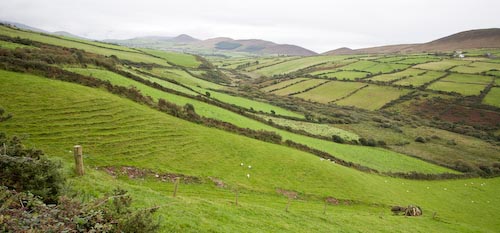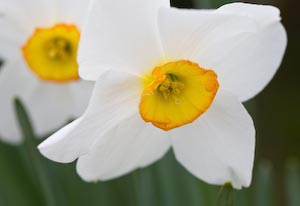2021-07-13: The rest of the showcases from Turkey are now
Flash-free! I took the opportunity to re-render most of the shots and
extended, sometimes substantially, a few of the
shows. Turks show has
been hugely extended from the very short original sequence. There were
so many interesting people that we met in
Turkey. Looking Up in
Istanbul is the same show but the images have been reprocessed
to 2021 standards. Hagia
Sophia has had some new content added and all the images have
been refreshed to 2021 processing standards.
©2008 & 2021 Marshall Ikonography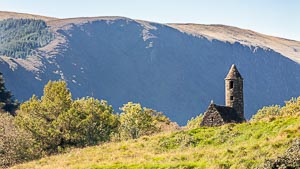
2021-07-07: The Turkish Treasures, Sacred Places, England 2010 and Irish Landscapes 2008 are now updated to remove the requirement for Flash.
2021-06-30: Next on the list: rebuild the showcases that still require Adobe's now obsolete Flash software to work. First up: a new and extended Kaua'i showcase.
2021-04-01: Spring is here, but we're still keeping safe and local. When our attention is focused on photography, we're slowly working through the photos from the 2019 trips but also revisiting and reprocessing (with modern techniques and software) to bring new life to old photos) images from Spain, Greece and USA from 16 to 18 years ago!
2020-09-07: Just a few small updates as we slowly add to the images available on Alamy. The pandemic has snuffed out our international travel plans but has made time for what should have been a great catchup from the archives. At the 6 month mark that catchup/cleanup is just starting to gather steam.
2019-01-24: Happy New Year! We've finally got our ikonog.com
domain email up and working again so the primary contact address for Marshall Ikonography is again 
2018-11-21: The front page has been simplified to work better on small screen devices like phones. To that end, the front page image takes less screen space but can now be selected to connect to the new Front Page Archive which displays a larger, more detailed view of the current and past front image photos. Some minor adjustments and corrections to Peter's biography page and Image Showcase were also made.
2018-06-06: The old web sites are gone -- just www.ikonog.com and ikong.com at their new host. Email is now via gmail only. And spring/summer is here!
2018-05-22: We're back on-line again. We've been having some DNS troubles getting our domain moved to a new provider. We're not quite there yet so futher glitches might still be down the road for the next little while.
2018-01-08: We've moved! The website's official address is now www.ikonog.com and we're being hosted by the Google cloud. We'll gradually re-direct and wind down the other web sites. Our new Marshall
Ikonography email address is shopikonography@gmail.com
2016-10-02: Google Custom Search replaces our local web site search since the old one was failing and not nearly as smart. Also some minor optimizations for small (phone-sized) screens.
2016-09-26: Finally, a new showcase has been added after a year's hiatus. See the new Yucatan Portraits showcase now!
2016-09-16: We now have over 5000 images on sale at Alamy. The slightly health delayed images from the very green Azorian island of São Miguel finally put us over the top.
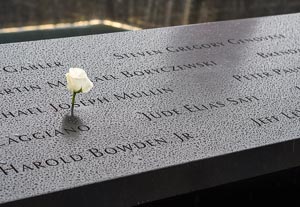
©2014 Marshall Ikonography
2015-02-01: We did lots of walking (much of it in the rain!) during our visit to Manhattan in December. This white rose was enjoying the cool damp weather in a moving memorial that seemed custom designed to hold small tokens like this flower in rememberance. I've since learned that a rose is placed on the birthday of each victim so Mr. Mullen's birthday would have been the day we visited, December 3rd. Note that there's a Thomas Harold Bowden Jr. named in this section --perhaps a distant relative of Peter's?
Just like on our pre-Christmas visit to Vienna a couple of years ago, many of the images on our New York trip were taken at dusk or at night. The days are so short! The in body image stabilization (IBIS) on the Olympus EM-5 and that camera's good high ISO capabilities were appreciated since we were travelling light and didn't pack or carry a tripod. Since we were taking the Amtrak train to NYC starting in Albany we managed a few shots of the downtown buildings around the New York State Capitol on a windy, cold night before we caught the early morning train. So have a look at the December in Manhattan showcase of our favourite shots from our visit.
Next stop, later this month, is Oahu's North Shore followed by a return to the Big Island of Hawai'i after a nearly 10 year absence. We can hope that there'll be lots of sunshine to contend with.
2014-04-04: Marshall Ikonography is one of the top 500 selling photographers to the massive stock photography agency Alamy. Only in the top 500? Well that's in the top 1.5% of their over 30,000 contributors that have made a total of over 46 million images available for sale. Some good stuff among my specially selected 3600 or so! In percentage terms, Marshall Ikonography only has 0.008% of the images in the collection.
Have a browse of the selection currently on sale at Marshall Ikonography on Alamy.
2013-12-05: World of Stock, our Canadian agency in Vancouver, plans to shut down operations by the end of 2013. As owner Steve Smith says in a recent email:
Unfortunately it is just no longer feasible to operate our library with the current volume of sales, given the industries massive shift to subscription / micropayment sites.
We've had a few good sales through World of Stock and strangely it seems that when there's a dry spell on Alamy a very welcome sale comes through at WoS. Recent sales have been few and small however. We wish Steve and Judy all the best in their new endeavours.
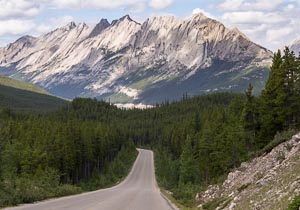
©2012 Marshall Ikonography
While World of Stock's departure simplifies our stock image library processes it does mean that this site is now the only way to order prints of Marshall Ikonography images. It doesn't look like MyLoupe's successor is going to do anything quick so we're down to one agent. Our stock images will continue to be available via our long time agent Alamy.
2013-03-03: Enjoy the new Jasper National Park showcase and remember the summer!
2012-07-26: MyLoupe, our distributer in the USA, has shut down their operation. The images that they were selling will now be part of the Universal Images Group. If UIG makes their site available we'll link to them, but for now they're concentrating on large institutional buyers and integrating the MyLoupe images into their collection.
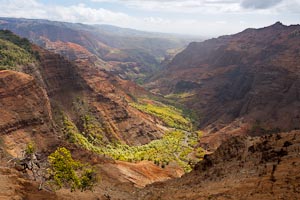
©2010 Marshall Ikonography
2011-11-10: We now are able to print up to 24 by 36 inches. That's about a 4x size increase. I find that images printed at this size take on a special depth and richness. We offer plain paper prints at this size as well as two kinds of plaque mounting and two canvas transfer-based products:
- Plaque mounting on a pressed wood product about 5mm thick with black borders.
- Deep Plaque mounting is similar to above, but a light-weight frame is included so that the piece has about 1 inch depth. The edges are painted black.
- Canvas transfer with taped edges. The full sized print is tranferred to the front surface of a canvas covered frame. Black tape goes around the edge. This format is most suitable for adding an outer frame.
- Canvas transfer with wrapped edges. This modern mounting technique
dispenses with the need for a frame by wrapping the image
(or an extension of the image) around the edges a light-weight wooden frame.
A couple of inches of the image goes around the corner so the finished size of
these prints is up to 22x34 inches.
This is currently my favourite for the large format prints. They look very sleek and modern on a wall.
To celebrate the new capabilities a new show has been added to the showcase. Poster Selections highlights images that are especially suited to large scale printing.
2011-06-08: A new showcase, Kaua'i Land and Sea highlights some beautiful scenes from the magical Hawai'ian island of Kaua'i. Kaua'i is one of the older and therefore more eroded islands in the chain. One of its star attractions is Waimea Canyon, a red rock canyon landscape sometimes referred to as the Grand Canyon of the Pacific. Mark Twain often gets credit for this superlative but my reading shows that he didn't ever get to the island of Kaua'i.
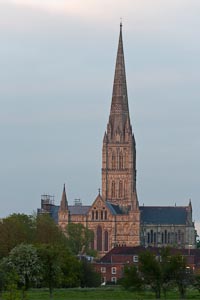
©2010 Marshall Ikonography
2011-05-20: The long promised first showcase from our England trip of last spring. I've put together a sampling of images from sacred places, mostly churches, that we visited. You can access it from the Showcases page or via Sacred Places 2010. I'm experimenting with a new flash-based slide show presentation for this showcase so tell me how you like it.
We'll try to get at least one more England showcase up over the next week or two. Then of course we have to share a bit of Kaua'i. We're into peak wedding season now, so expect delays!
2011-05-15: Finally an update! We've changed the front picture since last July, but not much else. This update was pretty cosmetic as we changed the font used to render Marshall Ikonography and many of the page titles to make use of a classier Copperplate Gothic. This entailed a few other code simplifications, the introduction of a cascading style sheet and even the fix of a typo or two!
2010-07-07: A minor reorganization of the travel page to make it more category oriented was completed today. There's now Image, News, Purchasing Prints and Licensing Images categories. We may shuffle these around a bit over the next few days. Also the instructions for ordering have been updated to make it clear that we don't charge or collect HST. I also took the opportunity to pull the prices into the bottom of the ordering page making it less hidden and easier to use.
We did make it to England once the ash cloud cleared. We were just a few weeks later than expected. A portfolio or two coming soon once the backlog has cleared a bit here. In the mean time, a new shot of St Paul's cathedral in London graces the travel page.
The delay on the trip to Cornwall also allowed us to make a couple of trips to the Boston area. The lure of an almost par Canadian dollar and a house that we could borrow was too much to pass up!
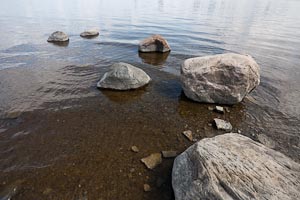
©2010 Marshall Ikonography
2010-04-20: The ash cloud over the United Kingdom has left us in a virtual limbo. Our scheduled flight to London was cancelled yesterday a few hours before we were to board. The first available replacement is almost 2 weeks from now, but we are on a (very long) waiting list to go sooner. But if we don't hear shortly we'll likely just go for the early May flight and push back the return. That would still mean that we can use the London flat for which we've made a non-refundable deposit. Everything is still packed and we're trying to live off the remains. The fridge is getting a bit empty though as we were trying to wind things down.
In the mean time we'll try to take in some of the local sites. Perhaps the tulips are up early in Ottawa due to the unseasonably warm late winter and early spring. There must be some National Capital Commission magic -- everything else is ahead of schedule, but the tulip beds are not blooming yet. They must be waiting for the official start of the Tulip festival at the beginning of May. So it is calm water and rounded glaciated rocks...
2010-04-17:
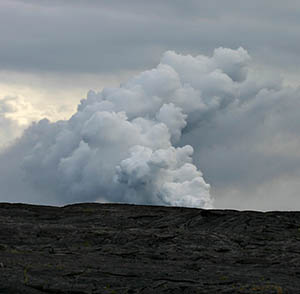 With jury duty finished (we found the defendant guilty of one count and not
guilty on another) we've been headlong into the planning and preparation
for a three week trip to Cornwall. Just to spice things up a bit, we've
added on four extra days in the great city of London before our
flight back to Ottawa. We're going to try to include Bath and perhaps even the
Iron Bridge gorge with our jaunts around the coasts, moors, towns and
villages of Cornwall.
In London we'll have a fully equipped flat near the Earl's Court
tube station so we'll be exploring that
great city by underground and on foot. It has been years since we've done
more than just pass through Heathrow in England.
With jury duty finished (we found the defendant guilty of one count and not
guilty on another) we've been headlong into the planning and preparation
for a three week trip to Cornwall. Just to spice things up a bit, we've
added on four extra days in the great city of London before our
flight back to Ottawa. We're going to try to include Bath and perhaps even the
Iron Bridge gorge with our jaunts around the coasts, moors, towns and
villages of Cornwall.
In London we'll have a fully equipped flat near the Earl's Court
tube station so we'll be exploring that
great city by underground and on foot. It has been years since we've done
more than just pass through Heathrow in England.
Of course all of this planning and our specific day train tickets might be for naught if there isn't a way to fly into Europe. The huge volcanic ash cloud could still cancel our flight next week. On the whole, of course, we'd rather stay at home than fly in a plane with failing engines!
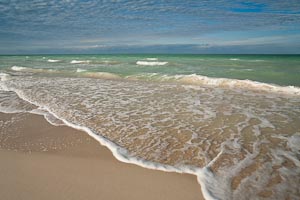 2010-03-31:
Again the long pause in entries. I guess that I'm just going to have to
get used to the fact that I'm not a very regular contributor here.
It doesn't actually mean that there isn't any news, just that I'm not getting
around to writing it up.
2010-03-31:
Again the long pause in entries. I guess that I'm just going to have to
get used to the fact that I'm not a very regular contributor here.
It doesn't actually mean that there isn't any news, just that I'm not getting
around to writing it up.
In January we spent a few weeks in Mexico. This is our third trip to the Yucatan and each time we get a little more adventurous. This year the weather really cooperated well. While we did manage to log some beach time near Tulum we spent much more of our time touring since the opressive heat and humidity that characterized our trip a couple of years ago just wasn't on this time. While the locals shivered in their hammocks we enjoyed the brilliant sunny days that were perfect for rambling around ancient ruins, visiting wildlife sactuaries and exploring old colonial cities.
Through my brother (who has built and is now renting a couple of
vacation houses in Tulum)
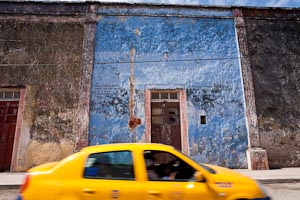 we'd previously met a family that had recently moved to Merida.
We spent a weekend touring that old colonial city with its almost continuious
festivals and its slightly crumbling architecture of the old centre. The
Mexicans are very keen on festivals that celebrate their history
and huge murals and other public art that explores their long history in
North America.
we'd previously met a family that had recently moved to Merida.
We spent a weekend touring that old colonial city with its almost continuious
festivals and its slightly crumbling architecture of the old centre. The
Mexicans are very keen on festivals that celebrate their history
and huge murals and other public art that explores their long history in
North America.
While January isn't prime season for finding large flocks of pink
flamingos on the north shore of the Yucatan we did find a few in our
guided boat tour of the
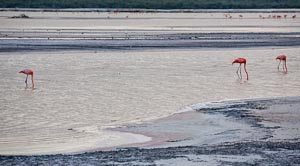 Rio Lagardos wildlife preserve. But we saw almost as many when we just
drove out along the old salt evaporating ponds. The added bonus there was
that we could get them to dance to the latin music coming from the
satellite radio.
Rio Lagardos wildlife preserve. But we saw almost as many when we just
drove out along the old salt evaporating ponds. The added bonus there was
that we could get them to dance to the latin music coming from the
satellite radio.
Once you get out of the major tourist areas the small market towns are
a lot of fun to explore. The hotels are inexpensive and quite adequate and
the towns, full of life, colour and fresh fruit seem quite safe. You can wheel
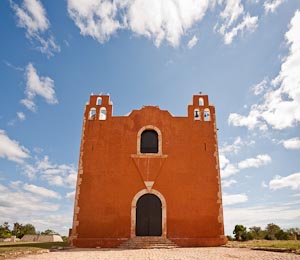 into a tiny village and find that they've been working on restoring their
huge Franciscan church that could certainly hold the entire population a
few times over. Or find a small roadside stand staffed by a pair of
kids with all the grapefruits (so sweet) piled up in neat pyramids. In between
there's the major ancient stone cities of the old Mayan civilization. The
weather was perfect during our visit to Uxmal and to a few of the smaller or
less reconstructed sites
further south. We had many of these partially restored ruins almost to
into a tiny village and find that they've been working on restoring their
huge Franciscan church that could certainly hold the entire population a
few times over. Or find a small roadside stand staffed by a pair of
kids with all the grapefruits (so sweet) piled up in neat pyramids. In between
there's the major ancient stone cities of the old Mayan civilization. The
weather was perfect during our visit to Uxmal and to a few of the smaller or
less reconstructed sites
further south. We had many of these partially restored ruins almost to
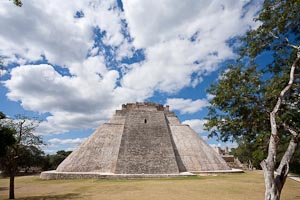 ourselves when we arrived near opening time or any time for the smaller sites.
ourselves when we arrived near opening time or any time for the smaller sites.
A productive trip but we left more for a future visit. Next time we'll wander around Coba, get to Palenque and perhaps even venture as far as San Cristobal de las Casas in Chiapas. After all we're really enjoying the coffee from around there -- our supplies are dwindling.
2009-11-06:
It has been a busy fall this year. While we didn't travel
too far from home, we have did launch a new assignment-based
industrial and event photography business. During late
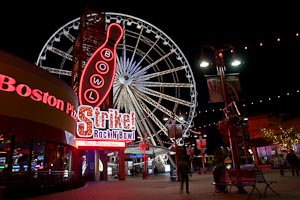 September and much of October we were photographing
products, processes and events for an inovative armour
retrofitter (or as they say "holistic survivability
solutions"), Armatec Survivability in London,
Canada. With all the IED
activity in Iraq and Afganistan these days,
it is a rapidly growing business. We're hoping that this
will lead both to an ongoing relationship with Armatec and
also to referrals for other assignments in the future.
To that end, the
top level of
the Marshall
Ikonography site has been replaced with a page that
describes the new services as well as providing a link off
to the original travel stock and fine art print
pages. A new Event
Portfolio and
a Industrial/Architectural
Portfolio
have been added to the site and are linked into the new simpler front page.
September and much of October we were photographing
products, processes and events for an inovative armour
retrofitter (or as they say "holistic survivability
solutions"), Armatec Survivability in London,
Canada. With all the IED
activity in Iraq and Afganistan these days,
it is a rapidly growing business. We're hoping that this
will lead both to an ongoing relationship with Armatec and
also to referrals for other assignments in the future.
To that end, the
top level of
the Marshall
Ikonography site has been replaced with a page that
describes the new services as well as providing a link off
to the original travel stock and fine art print
pages. A new Event
Portfolio and
a Industrial/Architectural
Portfolio
have been added to the site and are linked into the new simpler front page.
But it wasn't all industrial work and no travel this month. We managed to squeeze in visits to Niagara Falls, a couple of Frank Lloyd Wright houses around Buffalo NY and two Oktoberfest celebrations in two separate provinces!
We hadn't been to Niagara Falls for years
and combined with a visit to a couple of FLW houses made
this a very good short get-away. The town itself has
become almost like a mini-Vegas with all of its amusements
and huge hotels. I was particularly struck by the stark
contrast between the bright whites of the Skywheel and the
inky dark sky.
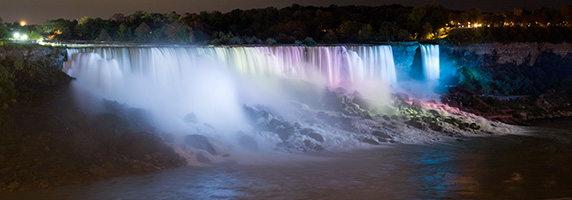 We were told that the mist is much worse
now at the Horseshoe Falls because the prevailing winds
are blocked by the height of all the new hotels. I could
believe this since we never did see those falls without a
huge ball of mist obscuring much of the base and even the
middle of the rim above. The American
falls were much clearer and therefore photogenic. I've included a colourful
nighttime panorama of those falls with their Bridal Veil
side-kick stitched from three long exposure shots. Along
the Niagra River parkway we happened upon the very interesting
Temple of the Ten Thousand Buddahs. They seemed to be in
the process of receiving carved Buddahs by the hundreds so
it might be quite new. It was too bad they only had tours on weekends and in
the summer but I suppose that that means we'll have to
plan a return journey.
We were told that the mist is much worse
now at the Horseshoe Falls because the prevailing winds
are blocked by the height of all the new hotels. I could
believe this since we never did see those falls without a
huge ball of mist obscuring much of the base and even the
middle of the rim above. The American
falls were much clearer and therefore photogenic. I've included a colourful
nighttime panorama of those falls with their Bridal Veil
side-kick stitched from three long exposure shots. Along
the Niagra River parkway we happened upon the very interesting
Temple of the Ten Thousand Buddahs. They seemed to be in
the process of receiving carved Buddahs by the hundreds so
it might be quite new. It was too bad they only had tours on weekends and in
the summer but I suppose that that means we'll have to
plan a return journey.
When the Martin Darwin house was built in an early suburb
of Buffalo early in the 20th century it's innovative
prarie style must have
clashed with the existing half timbered and Norman
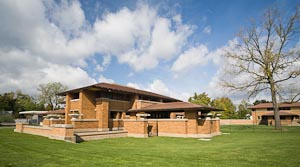 inspired houses of the neighbourhood. Its long
horizontals jump out strongly today partially
because they haven't got much of the landscaping done. Tours
of both of the publicly accessible Buffalo FLW houses were
interesting and informative. The tour was
very well done by a former English teacher at the city house but a
little scattered by the near octagenarian neighbour at the
country cottage on the lake. You
can certainly tell that the city house has the bulk of the funding.
We were surprised to find that the restorations still have a
very long way to go. While the outsides are pretty much
restored (or rebuilt) back to their early 20th century grandeur, the
interiors still require millions of dollars of
work. Sometimes I doubt that the result is worth the
effort since it is now so expensive to reproduce the
relatively ordinary items like leaded windows of 1901.
inspired houses of the neighbourhood. Its long
horizontals jump out strongly today partially
because they haven't got much of the landscaping done. Tours
of both of the publicly accessible Buffalo FLW houses were
interesting and informative. The tour was
very well done by a former English teacher at the city house but a
little scattered by the near octagenarian neighbour at the
country cottage on the lake. You
can certainly tell that the city house has the bulk of the funding.
We were surprised to find that the restorations still have a
very long way to go. While the outsides are pretty much
restored (or rebuilt) back to their early 20th century grandeur, the
interiors still require millions of dollars of
work. Sometimes I doubt that the result is worth the
effort since it is now so expensive to reproduce the
relatively ordinary items like leaded windows of 1901.
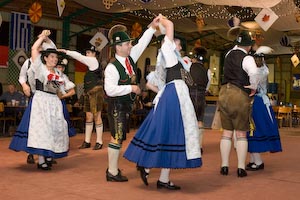 October is a long month, so there's time for at least two
Oktoberfest celebrations, right? Ladysmith Quebec has been
inviting people to its celebration for 19 years and while
the 2009 parade was a little lame, the dancers were top
notch. My only disappointment was that by Sunday afternoon
they were running so low on German beer that my second had
to be a Labatts product. Later, in Kitchener the Schwaben
Club hosted our party and
kept our glasses brimming with brew. They don't
even bother to stock any German beers on tap. A fun night out, but we
probably don't need to try it again for another decade or
so!
October is a long month, so there's time for at least two
Oktoberfest celebrations, right? Ladysmith Quebec has been
inviting people to its celebration for 19 years and while
the 2009 parade was a little lame, the dancers were top
notch. My only disappointment was that by Sunday afternoon
they were running so low on German beer that my second had
to be a Labatts product. Later, in Kitchener the Schwaben
Club hosted our party and
kept our glasses brimming with brew. They don't
even bother to stock any German beers on tap. A fun night out, but we
probably don't need to try it again for another decade or
so!
I'm grounded in Canada for a couple weeks now since my passport needs renewing. Amazingly it took just 12 minutes in line to get the process started at the downtown Ottawa passport office. I guess all the queues have been used up trying to get H1N1 shots.
2009-09-25: I do hope that you haven't been waiting with bated breath for Marshall Ikonography news. It turns out that the Eastern Townships trip didn't materialize. Even the Adirondack mountain tour didn't materialize until much later in the summer. Mostly it was the black fly season that kept us home in May! But now its time to keep things up to date again. I'll use this entry to do a quick summer summary.
It was a fairly quiet summer here at Marshall
Ikonography. The weather was on the whole, cool and rainy and there was
lots of stock photography to catalog, index and upload. Indeed, there are
still excellent images of Denmark, Turkey and Ireland in the
processing queue.
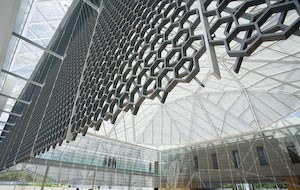
As for travel, we kept pretty close to Ottawa. We took in events in the Capital Region and restricted our travel to easily accessible road trips to Ontario, Western Quebec and upstate New York.
In early June the Doors Open
event in Ottawa provided a great opportunity to
see some of the architectural stars in our home
town. The tour of the Ottawa Citizen proved very
interesting and perhaps even historic as such large
newsprint-based publications phase out of existance over the
next few years. But it was the newly opened Delegation
of the Ismaili Imamat which is the Canadian
headquarters of the Aga Khan Development network on Sussex
Drive that provided what I
thought was the most dramatic image.
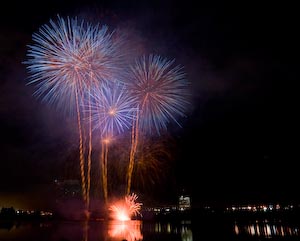
In early August, we attended Les grands feux du
Casino du Lac-Leamy a fantastic fireworks competion
for two nights. I have learned that if you want to photograph fireworks, a
tripod is necessary! I had one along for the second
night. Exposures of over 1s are just too much for my
ageing body to hand hold! RAW images also make the
capturing of the colour more likely. The second night was calm
compared to the howling wind of the first evening so that
the sound part of the show actually worked! In between
various trips to the cottage we took a road trip
down to Southwestern Ontario included
tour of the north shore of Lake Erie and Long Point in
particular provided some picturesque images of the
transformation of their commercial fishing villages into holiday
and retirement villages.
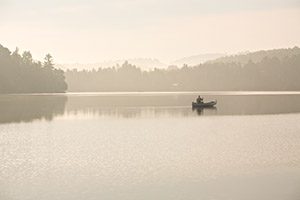
Later in August we spent a few days touring
Adirondack Park in upstate New York from a base in the
Olympic village of Lake Placid. The view from peak of Whiteface
mountain is quite extraordinary (on a good day -- it was
zero visibility the first time we tried to go up!). It was
our first visit to the peak for over 40 years. We did
note that the sign had gone metric (even in the United
States!).
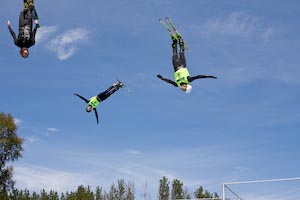 One of the highlights near Lake Placid was the Wild and
Wet show put on by the
freestyle skiers practicing and competing for a place on the
US Olympic team for the winter games coming to Whistler, BC,
Canada in February of next year. They skied down from three
separate jumps, each covered with watered artifical snow,
whirling and twirling through the sky before
splashing down in a deep pool of frothing water. Only as
they exited the pool did the skis come off.(Bubbles in the
water are to make sure that the competitors can distinguish
it from the bright blue sky as well as to break up the
surface for a "softer" landing.)
One of the highlights near Lake Placid was the Wild and
Wet show put on by the
freestyle skiers practicing and competing for a place on the
US Olympic team for the winter games coming to Whistler, BC,
Canada in February of next year. They skied down from three
separate jumps, each covered with watered artifical snow,
whirling and twirling through the sky before
splashing down in a deep pool of frothing water. Only as
they exited the pool did the skis come off.(Bubbles in the
water are to make sure that the competitors can distinguish
it from the bright blue sky as well as to break up the
surface for a "softer" landing.)
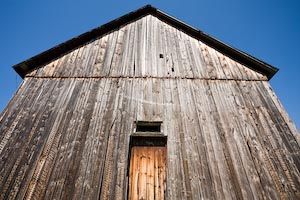 I continue to accumulate images of old log houses and
weathered barns from our excursions in the Pontiac while we
base ourselves at the cottage on Barnes Lake. This one was
just glowing in the warm early September sunshine.
I continue to accumulate images of old log houses and
weathered barns from our excursions in the Pontiac while we
base ourselves at the cottage on Barnes Lake. This one was
just glowing in the warm early September sunshine.
Next week we're off to Niagara Falls, the Martin House (by Frant Lloyd Wright) in Buffalo and a visit to the third largest Octoberfest on the planet in Kitchener. But plans are afoot for a longer trip later this fall. Our travelling feet are getting very restless.
P.S. If you scroll down a bit, the 2009-04-03 entry on the Turkish Treasures book has been updated with a couple of images of the finished product.
2009-05-15: A couple of weeks ago at the CAPA judging course I learned from my table mate (who sported a new 5d Mark 2) that there was a pending recall of Canon 5d cameras. It seems that the adhesive that is used to attach the mirror to the "flapper" can fail. I hadn't sent in my warranty card so that's probably why I didn't receive a letter. I registered on the Canon site and a couple of days later I received an invitation with detailed courier instructions via email to send my camera in to the Mississagua service center. They said that it would take 15 to 20 days once they received the camera.
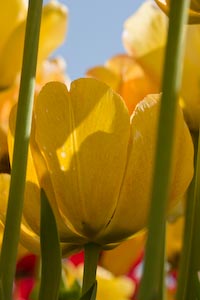 I packaged up my camera last Wednesday. Purolator came to
the door late in the afternoon the same day to whisk it off
to Toronto. It was there the next day. Much to my
surprise the camera was returned only 7 days later with the fix
in place. Unfortunately they didn't do anything else. The
viewfinder is still a little dirty and the big Tau
shaped blob on the sensor is still there. I had hoped that
they'd give me a complementary cleaning for my trouble. I'd
heard that some US centres were doing this. Oh
well, sensor swab time...
I packaged up my camera last Wednesday. Purolator came to
the door late in the afternoon the same day to whisk it off
to Toronto. It was there the next day. Much to my
surprise the camera was returned only 7 days later with the fix
in place. Unfortunately they didn't do anything else. The
viewfinder is still a little dirty and the big Tau
shaped blob on the sensor is still there. I had hoped that
they'd give me a complementary cleaning for my trouble. I'd
heard that some US centres were doing this. Oh
well, sensor swab time...
The 5d-free week did force me to pull my old Digital Rebel out of the the storage drawer and get me to re-learn a few of its little quirks (like how to turn up the fill flash a bit with the patched firmware). The hardest thing for me was estimating the field of view. We went on a bike ride down the Ottawa River bikepath to take some photos of the tulips and other flowers and I constantly found myself having to step back a couple of steps each time I tried to frame a shot. I was able to get used to the smaller viewfinder view, but the size of the display in the back was harder to take. The buffer in the camera also proved limiting. After about three or four shots there's a long wait with the Rebel while it laborously writes the data to the CF card. It is unusual for me to out run the processor in the 5d. Of course it is nice to push in a single CF card and have over 500 RAW shots available for an afternoon of shooting! The Rebel worked well, but I didn't try pushing the ISO beyond 400 much and never beyond 800. You just have to resort to the pop-up flash on that camera.
With the 5d back and my final wrist X-ray to be completed today, all it right in the world so we're currently planning a short trip to the Eastern Townships of Quebec, for next week.
2009-05-10:
My entry, five 16"x10" warmly toned monochrome prints
entitled Danish Dreams, in
the RA Photo Club's
Bruce Wilson Competition
faired well in the competition last Tuesday. Although the
submission as a whole didn't win,
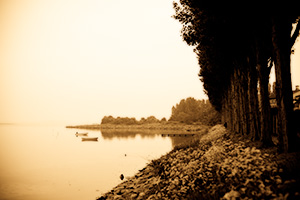 the entry was praised by the judge for its lyrical feel and
painterly look to the images. The final image of the
sequence Aero Shore was singled out as an honorable
mention print. That was interesting since it was that
image that really started this sequence. I saw it
originally, just after sunset while strolling around
Aeroskobing as a scene from an old photo album from the 1930s
it was just begging for a retro look.
the entry was praised by the judge for its lyrical feel and
painterly look to the images. The final image of the
sequence Aero Shore was singled out as an honorable
mention print. That was interesting since it was that
image that really started this sequence. I saw it
originally, just after sunset while strolling around
Aeroskobing as a scene from an old photo album from the 1930s
it was just begging for a retro look.
Thirteen photographers entered the Competition this year. Bill Young's winning entry was an exquisite sequence of dogwood blooms in the Smokey Mountains, each warmly toned and printed on Ilford's Gold Fibre Silk paper. The blooms had a subtle Orton effect applied (much the same technique as I used in Dreams). Looking at the sequence the flowers seemed to be dancing against the dark brown backdrop of the rainy woods. Other notable entries included one excellent one from the Dante was Here group: a series of diptychs of auto mechanics and their tools printed on metalic paper and mounted on steel. Barbra Bolton's sequence of images Mexicans turning away from the camera on the streets of San Miguel de Allende was given an honourable mention.
I was disappointed by the comments from the judge. I felt that while he did a good job of judging he wasn't able to articulate his thought processes well. Also, the judge didn't provide much in the way of constructive criticism and suggestions for improvement, even if the comment was only in technical aspects of print making. I would have expected a little more from a master print maker. Still, I found the emphasis on print making techniques a little too strong which meant very little beyond "I like this" for composition and form. After attending the CAPA judging course, perhaps I'm expecting too much of an untrained judge.
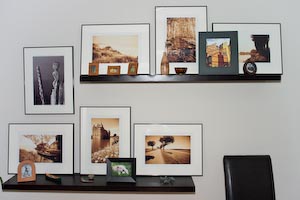 The collection, now framed under glass and extended
by an extra image has found a
temporary home at our entrance gallery. It looks very
well especially when the late afternoon light streams in
the windows and doors to light up the space.
The collection, now framed under glass and extended
by an extra image has found a
temporary home at our entrance gallery. It looks very
well especially when the late afternoon light streams in
the windows and doors to light up the space.
2009-05-05: Over the weekend I attended the Ottawa version of the Canadian Association for Photographic Art (CAPA) sponsored photo judging course with around 50 others drawn from CAPA members and Ottawa photo clubs. It was a one day intensive and interactive seminar on how to constructively judge and provide feedback to participants of a photography competition. While it was oriented toward the rules of CAPA contests, the principles and techniques are easily applicable not only to other competitions, but in evaluating one's own work or constructively critiquing others. For me, one of the major problems with the typical photo club judging is that the judges are required to evaluate and comment after seeing an image for less than 1 minute. The volume of entries and the limited time to do the judging makes allowing more time a major problem. Of course this leads to unhelpful comments from rushed judges and to evaluations that are skewed heavily toward initial impact. This then is likely to lead to only a certain type of image scoring well in a typical competition. According to the presenters (all experienced judges), CAPA isn't keen on this sort of bias as it tends to stifle innovation and more thoughtful pieces, but they're short on ways to aleviate it. The approach seems to be to train more judges to work quickly!
I wouldn't be the best judge in the current environment. I'm not quick enough in my evaluations. I like to let an image settle in for a bit before pronouncing on it. I find this even with my own work. Although there's often a certain excitement even in the field for some images, most of the best work only reveals itself months after the shoot.
During the course, the section on abstracts was the most difficult for me. I'm clearly going to have to spend a bit more time studying this form and developing an educated eye. Time to dig up my copy of Gregory's The Intelligent Eye to give at least one of my eyes a refresher course! To keep the eye/I theme going, my other difficulty was keeping the "I" out of my assessments. CAPA is keen to have judges make universal prononcements with authority and conviction and that means leaving out the "I think"s or "in my opinion"s!
Tellingly, the RA Photo Club does have a couple of refreshing alternatives to the massive competition:
- One comes up on Tuesday this week where members are invited to submit five monochrome images with a theme to be judged and commented "live" during the club's meeting. There tends to be fewer entries to this competition and therefore more interaction between the judges and the photographers. This year, I'm entering for the first time with a series from the Denmark Dreams sequence.
- The second is the monthly slide showcases where a series of up to six images is shown without formal comment or judging. I'm a regular contributor to these. Comments do come of course, but only in the informal atmosphere of the meeting break.
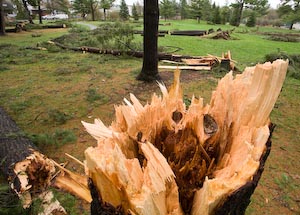 2009-04-28: Today we toured some of the destruction caused by the
mini-tornado, downdraft or big wind
that Britannia Park and other parts of the city endured last
Saturday. It was the first major thunderstorm of the
season. The news reports hadn't prepared us for the scale of the
destruction in one small beautiful pine-filled area of the
park. A small play structure was just surrounded by fallen
branches and trunks of 100 year old pines.
2009-04-28: Today we toured some of the destruction caused by the
mini-tornado, downdraft or big wind
that Britannia Park and other parts of the city endured last
Saturday. It was the first major thunderstorm of the
season. The news reports hadn't prepared us for the scale of the
destruction in one small beautiful pine-filled area of the
park. A small play structure was just surrounded by fallen
branches and trunks of 100 year old pines.
We met a long time resident of the neighbourhood told me that the soil is very thin and sandy around there so the trees aren't well anchored. My informant told me that she'd lost a prized 40 year old blue spruce in her backyard during the same storm. Her back garden was still filled with the branches and debris. It probably would have been much worse had more leaves been out on the trees. I did hear that many of the maples in Beechwood Cemetery had been toppled, however. The large trees here and futher east on Carling near the Transitway all missed the houses that they're growing beside. Just the right direction for the wind, every time!
In Britannia the cleanup had started so that it was now fairly safe to wander through the grove although I did still find a couple of worryingly split trunks. I felt that the damp drizzly weather gave the scene more character than yesterday's bright warm sun.
2009-04-27:
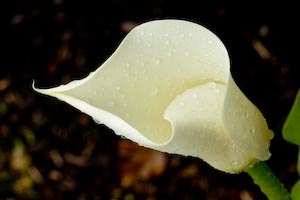 Spring has arrived early here in Ottawa. As I write this
the temperature is reaching toward a record 30 degrees.
That's hot for July! It has had a great effect on
some of our flowering plants and there are daffodils just
about showing their flowers in our normally cool (morning
sun only) back garden. A calla lily (originally from the
Azores), now in its second year in Ottawa
Spring has arrived early here in Ottawa. As I write this
the temperature is reaching toward a record 30 degrees.
That's hot for July! It has had a great effect on
some of our flowering plants and there are daffodils just
about showing their flowers in our normally cool (morning
sun only) back garden. A calla lily (originally from the
Azores), now in its second year in Ottawa
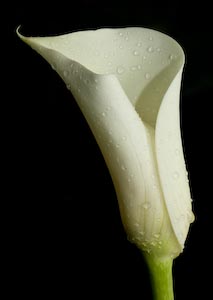 came up out of the basement a couple of weeks ago with sprouts already a few
centimetres high. Today it is slowly unfurling its first
green and cream flower. You can almost see the motion as
the tips grow!
Even the hackberry at the front of the house is getting into the act with
small proto-leaves sprouting on a branch or two and maples
all around are putting out lots of
tiny red flowers. Of course tomorrow is supposed to be
rainy and much cooler, but then we don't want all the
flowers to just last for a day.
came up out of the basement a couple of weeks ago with sprouts already a few
centimetres high. Today it is slowly unfurling its first
green and cream flower. You can almost see the motion as
the tips grow!
Even the hackberry at the front of the house is getting into the act with
small proto-leaves sprouting on a branch or two and maples
all around are putting out lots of
tiny red flowers. Of course tomorrow is supposed to be
rainy and much cooler, but then we don't want all the
flowers to just last for a day.
Last Friday I took part in the RA Photo Club's annual Focus Series launch with freelance travel photographer André Gallant and his presentation entitled Destinations & Photographing People. André's message at the presentation was a simple one for photographing people. Engage them before and after photographing whether their your brother's kids or a street vendor in Morocco. He knew the names of many of the people shown in his travel images and had stories to tell about each of them. As for the general travel photography (or Destinations), the message was similar: include people!
Of course he broke his rules too: taking pictures (and showing them) of people that didn't want their photograph taken and by including a long slide show of the dunes of Namibia that had no people present. The workshop might have been better than the presentation to a large audience, but it's 12 spaces were filled by lottery. And since I don't win lotteries, I didn't have a chance!
2009-04-03: (updated 2009-09-25)
A recent project has been to experiment with one of the
on-demand printing services that are popping up. Friends of
ours used their photos from our recent trip to Ireland as the basis
for a medium sized coffee table book. The book looked
pretty good.
It was nicely printed on heavy glossy paper and securely bound
with a good quality leather-like hard cover. As an optional
extra they added a very high-quality dust cover to make a
spectacular first impression. They'd chosen
a company in Montreal, PhotoInPress to do the
printing.
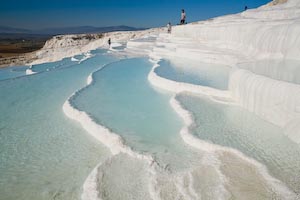
Having examined our friends book and finding that PhotoInPress had a program to allow professional photographers to create a test portfolio for a very reasonable price, we decided to try the "Pro" version of the PhotoInPress product. PhotoInPress claims that the professional software does less compression on the images sent and that the images are printed at 600dpi instead of the consumer version which is 300dpi. For our test book we chose a selection of images from our 2007 trip to Turkey. The resulting 8 inch by 11inch landscape book, Turkish Treasures, is beautiful. This is a reasonable way to physically present a series of photographs or a small portfolio. While the printed page doesn't have the "pop" of a well calibrated screen nor the absolute depth and resolution of an photographic ink jet image, there's something about the tactile nature of leafing through a bound book that is very satisfying.
The PhotoinPress bookmaking software, BookDesigner Pro, was
easy to use although its simplicity did
mean that we felt a little restricted in our choices. For
example, most of my images that are in the 2x3 size ratio of a typical
SLR but BookDesigner included only 2 template
choices that showed the full frame. The placement of titles is also quite
restrictive and in the end we found only two fonts that
would handle both the accents that we wanted to include in the
Turkish names and the size of the text box allowed with 2x3
shaped photographs. Of course, you can always use Photoshop
to overlay titles, place any needed white space and then
just print the page full bleed. That's exactly what we did
for the interior title page, but it does detract from the
simplicity of the process. PhotoInPress also doesn't provide any
sort of calibration -- they just ask for sRGB
images.
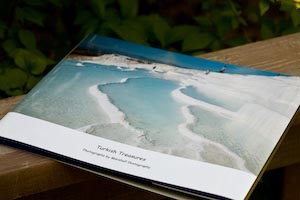 Nevertheless, the quality was good for the interior
pages and excellent to outstanding for the glossy slip
cover. The cover, I'm told, is printed by a different and much slower
process. It certainly costs to add a cover, but it also
significantly enhances the appeal of the finished
product. There were a few small bugs in the software, but
mainly it was leaving some of the French labels untranslated
into English.
Nevertheless, the quality was good for the interior
pages and excellent to outstanding for the glossy slip
cover. The cover, I'm told, is printed by a different and much slower
process. It certainly costs to add a cover, but it also
significantly enhances the appeal of the finished
product. There were a few small bugs in the software, but
mainly it was leaving some of the French labels untranslated
into English.
Once you have all the pages layed out, there's a preview on the screen and finally an upload to the PhotoInPress site. Two days later Canada Post knocks on the door with the finished book in a box. It really is quick.
I can't provide a copy of the book here but
a couple of image of the book accompany this entry.
Also, I can provide a
link to a new showcase made from
the images used. Please enjoy the new Turkish Treasures showcase
which is now available here and via the main page Image Showcases link.
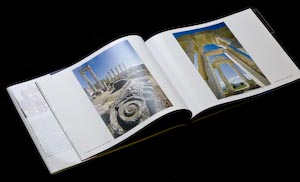 I'm curious now to compare the results of PhotoinPress's Kodak printer
which uses solid ink like a laser
with the liquid ink HP Indigo printers that other similar
services use. At the high end (we're talking five to seven
times the price!), Askabooks uses a recently
upgraded 6 colour process with their HP equipment. I
wouldn't be surprised to find that a new improved version of
the Turkish Treasures book was available soon, both to
explore the options of the PhotoInPress system as well as to
compare it to similar services.
I'm curious now to compare the results of PhotoinPress's Kodak printer
which uses solid ink like a laser
with the liquid ink HP Indigo printers that other similar
services use. At the high end (we're talking five to seven
times the price!), Askabooks uses a recently
upgraded 6 colour process with their HP equipment. I
wouldn't be surprised to find that a new improved version of
the Turkish Treasures book was available soon, both to
explore the options of the PhotoInPress system as well as to
compare it to similar services.
P.S. The cast is finally off! Unfortunately it has left my left hand stiff, inflexible and my arm and hand as weak as a new born kitten. Nothing a bit of physiotherapy and time can't cure. Probably six more weeks...
2009-02-25: I finally got down to re-rationalizing my off-site backup strategy. After fishing around the net for a while I came upon the Sourceforge project Synkron. That is a very sophisticated open source program for keeping multiple copies synchronized. I haven't had a chance to search out all the options, but the basic analysis and synchronization is much better than trying to do it by hand and its Multisync option looks very promising for automating much of the process. Synkron is superior to a commercial product from Moleskin that I was testing out. The analysis runs a bit slower, but the display is much more informative. Also the Moleskin product was limited to directories with fewer than 50 files which wasn't mentioned in the free for non-commercial use blurb on their site. Needless to say, very few of my image directories have fewer than 50 files.
I also tried the Clone function in Synkron, but ran into a bit of trouble in that it didn't do the deletions on the destination disk first (to make room for the new stuff) so I had to help it along by deleting much of the big stuff that I knew wasn't on the source disk to help it along. I'd also massively reorganized my main external backup disk so it made some sense to manually make the one to be cloned for off-site storage look at least similar to the on-site one before asking the USB2 bus to handle 400G of data transfer. After all, one big reason for using sync software was to save the copying time for the off-site disk. It still took an hour or two, but I'm expecting the next update to go faster.
Week two with a cast covering my left arm and much of my hand. I'm starting to be able to type with the fingers of my left hand! I'm really missing the skating (the canal's ice is supposed to have improved significantly) and cross country skiing.
2009-02-21: After a short break, we continued with our Tourists in Ottawa theme. After all Winterlude lasts for three weekends! Being a tourist can be hard.
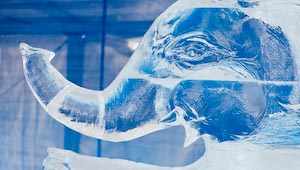 With the threat of a melt-down before the second weekend of
Winterlude, we took to the canal for what might be the last
skate of the season. The ice was great on Dows Lake, but
pretty chewed up elsewhere. Once I got to the lake I was
reminded about how nice it is to skate on smooth
ice. Perhaps we should have circled longer. Later at an
arena skate I had to learn how to corner again — the
curves are gentle on the canal.
With the threat of a melt-down before the second weekend of
Winterlude, we took to the canal for what might be the last
skate of the season. The ice was great on Dows Lake, but
pretty chewed up elsewhere. Once I got to the lake I was
reminded about how nice it is to skate on smooth
ice. Perhaps we should have circled longer. Later at an
arena skate I had to learn how to corner again — the
curves are gentle on the canal.
On Tuesday, we got out to see the ice sculptures in
Confederation Park, again before the predicted warm air
settled in. Many of the sculptures were covered with
silvered bubble wrap against the afternoon sun, but the
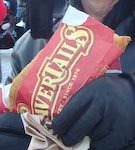 competition sculptures were in their tented protection and
quite visible. We made time to enjoy a Beavertail (sugar and
cinnamon, which are the best) — Obama tails weren't being
sold yet), the signature snack of winter in Ottawa! It was
better than I expected. The Beavertail is made with
wholewheat and after deep frying it is very well drained. I
hear that it has its origins in the Ukraine.
competition sculptures were in their tented protection and
quite visible. We made time to enjoy a Beavertail (sugar and
cinnamon, which are the best) — Obama tails weren't being
sold yet), the signature snack of winter in Ottawa! It was
better than I expected. The Beavertail is made with
wholewheat and after deep frying it is very well drained. I
hear that it has its origins in the Ukraine.
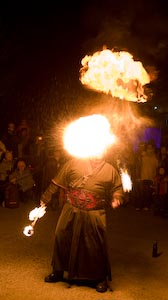 By Friday we'd experienced both a meltdown and a freeze
up. Down in Confederation Park we happened upon some fierce
fire eaters before our rendezvous with another sound and
light show — this time with friends and a shorter
lens. Later a few songs with the Jim Cuddy band demonstrated
the limitations of traveling light and only carrying a fast
50mm lens. The images just weren't as compelling as last
By Friday we'd experienced both a meltdown and a freeze
up. Down in Confederation Park we happened upon some fierce
fire eaters before our rendezvous with another sound and
light show — this time with friends and a shorter
lens. Later a few songs with the Jim Cuddy band demonstrated
the limitations of traveling light and only carrying a fast
50mm lens. The images just weren't as compelling as last
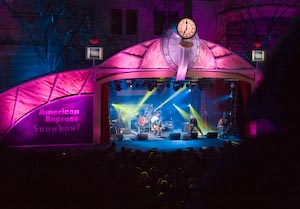 weeks shots with the 200mm. All was forgotten once we
experienced our early Valentines fine dining experience at
Taste of Winterlude at Benitz Bistro. We were all very well
fed with the excellent 3 course prix fix menu. All
in all an excellent Friday the 13th.
weeks shots with the 200mm. All was forgotten once we
experienced our early Valentines fine dining experience at
Taste of Winterlude at Benitz Bistro. We were all very well
fed with the excellent 3 course prix fix menu. All
in all an excellent Friday the 13th.
On Saturday, the canal was open for part of its length (but
only in fair condition), so we decided to visit the just
completed snow sculptures across the Ottawa River in
Gatineau's Jacques Cartier Park. They were huge, they were
massive and very fresh. The sculptors were still packing up
as we toured. We also managed see some snow slides, dog sled
rides and to take in an Inuit music performance including
lots of throat singing and some demonstrations of unique
Inuit competitive games.
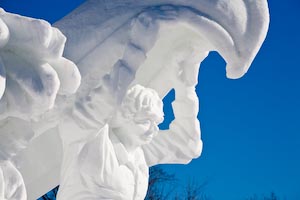
On Sunday we decided to get in our obligatory Winterlude
canal skate. The crowds weren't too bad, but the ice wasn't
nearly the advertised Good. We'd sharpened our
skates in the morning and since we were going to do some
touring after I'd slung my camera bag on my back for a short
afternoon skate toward Parliament Hill. My balance was a bit
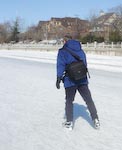 off and some wobbly ice soon had me falling. Falling
hard. Falling hard on my left hand. A kind passing skater
helped me up and I slowly skated to the Corkstown pedestrian
bridge. After getting lots of help to get my skates removed,
half the party skated back and then fetched me via the car
to our local hospital for an assessment at Emergency. Surely
just a sprain... Nope. After a quick X-ray and a long pause
before it was read, the sore hand was transformed into a
cast encased broken wrist. It took about 3 hours — much
better than my last visit to the Queensway Carleton's
Emergency Department. What is the sound of one hand typing?
A slow one. I can't drive shovel, open jars, shower or dress
without help. Turning on my camera is even a chore (the good
hand holds the camera, but the fingers of the injured one
are hardly strong enough to flick the now finicky on/off
switch. What a pain.
off and some wobbly ice soon had me falling. Falling
hard. Falling hard on my left hand. A kind passing skater
helped me up and I slowly skated to the Corkstown pedestrian
bridge. After getting lots of help to get my skates removed,
half the party skated back and then fetched me via the car
to our local hospital for an assessment at Emergency. Surely
just a sprain... Nope. After a quick X-ray and a long pause
before it was read, the sore hand was transformed into a
cast encased broken wrist. It took about 3 hours — much
better than my last visit to the Queensway Carleton's
Emergency Department. What is the sound of one hand typing?
A slow one. I can't drive shovel, open jars, shower or dress
without help. Turning on my camera is even a chore (the good
hand holds the camera, but the fingers of the injured one
are hardly strong enough to flick the now finicky on/off
switch. What a pain.
My tourist days are over for a while. Being a tourist can be very hard.
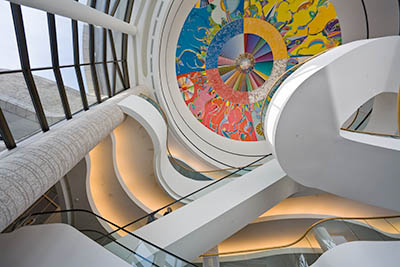 2009-02-07:
We've been tourists in our own
town for the past week. Earlier in the week we spent an entire
afternoon exploring the Canadian Museum of Civilization across the
river in Gatineau. I especially enjoyed talking with the volunteer
interpreters about ancient Egyptian clothing in the special exhibit
on the Egyptian burial rites and practices. While photographs are
allowed in most places in the museum, this exhibit done jointly with
a Boston museum is off limits to cameras. The building itself always
inspires though and my hot boots prompted me to take a snowy and cold
circuit around the famously curvaceous building.
2009-02-07:
We've been tourists in our own
town for the past week. Earlier in the week we spent an entire
afternoon exploring the Canadian Museum of Civilization across the
river in Gatineau. I especially enjoyed talking with the volunteer
interpreters about ancient Egyptian clothing in the special exhibit
on the Egyptian burial rites and practices. While photographs are
allowed in most places in the museum, this exhibit done jointly with
a Boston museum is off limits to cameras. The building itself always
inspires though and my hot boots prompted me to take a snowy and cold
circuit around the famously curvaceous building.
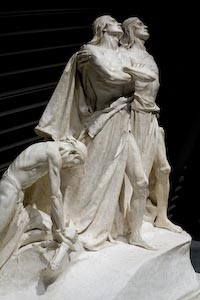 Thursday
evenings at Civilization Museum and at the Canadian War Museum are
free so we decided to spend a couple of hours after an early supper
visiting the relatively new War Museum. We'd explored parts of it
before, but ran out of time before we got to the modern wars. Turns
out that I'm more comfortable with the older wars! Perhaps it is the
noise or just too much killing and too close to home. Even though we
grew up with much of the Second World War (through our parents) and
with the cold war (through the eyes of a child), the heavy emphasis
on big armor and guns and other killing machines was too much. The
lower level full of tanks and armored cars just wasn't interesting.
But the plaster casts for the carvings at the Vimy Memorial did catch
my eye. I may have to re-read Jane Urquhart's The Stone Carvers.
Even at night the building itself is an interesting study.
Thursday
evenings at Civilization Museum and at the Canadian War Museum are
free so we decided to spend a couple of hours after an early supper
visiting the relatively new War Museum. We'd explored parts of it
before, but ran out of time before we got to the modern wars. Turns
out that I'm more comfortable with the older wars! Perhaps it is the
noise or just too much killing and too close to home. Even though we
grew up with much of the Second World War (through our parents) and
with the cold war (through the eyes of a child), the heavy emphasis
on big armor and guns and other killing machines was too much. The
lower level full of tanks and armored cars just wasn't interesting.
But the plaster casts for the carvings at the Vimy Memorial did catch
my eye. I may have to re-read Jane Urquhart's The Stone Carvers.
Even at night the building itself is an interesting study.
Friday, which is the beginning of this year's Winterlude festival started for us with a morning skate on the canal. We did the full 7km both directions and I only fell once. We'd thought that we beat the crowds of Winterlude by going earlier in the day. It would seem that there isn't much book-learning going on on Friday. There were families with children and then later it looked like whole schools of children swarming on to the ice. It was also the first day not to be bitterly cold for a while so there were lots of others (like us...) out too. When we started the sun was blinding. I'd lost my sunglasses earlier in the week so it was torture dodging all the bodies with the sun shining into my eyes as well as reflecting off the ice surface. Eventually it clouded over a bit and we turned north so it became easier. It was just about then that I fell. Ouch!
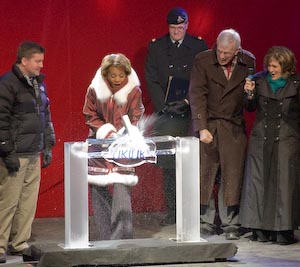
Later on Friday we joined the audience for the official opening of
Winterlude at the snowbowl. After waiting through too many
commercials for the festival on the monitors, a representative of one
of the sponsors, the chair and another official from the National
Capital Commission joined Canada's Governor General, Michaëlle
Jean to break the ice for Winterlude. This was followed by the
premier of a very creative sound and light show projected onto
Ottawa's old train station. The show, Ukiuk, included video,
animation and even fireworks. I was surprised that I liked it! They
made excellent use of the columns other architectural features the
old building (now a government conference centre) to enhance the
presentation. Surprising fireworks were included at appropriate
times. I especially enjoyed the flash of fire each time an animated
hammer hit its anvil.
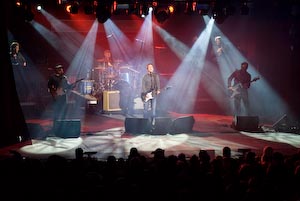 After Ukiuk — which means “winter” in
Inuktitut — Colin James and his band entertained us for well
over an hour. The stage light show looked good, perhaps enhanced by
the steam in the cold night air. The music, some of it familiar, had
lots of beat that even a somewhat rhythm-deaf person like me could
hear. It kept my boots a-thumping. The sound was at an appropriate
level too especially when wearing the obligatory earmuffs. Or, was
that just me keeping my toes from freezing? After their show they
seemed to put on another one as a long encore performance of three or
four more songs where Colin exchanged his electric guitar for an
acoustic.
After Ukiuk — which means “winter” in
Inuktitut — Colin James and his band entertained us for well
over an hour. The stage light show looked good, perhaps enhanced by
the steam in the cold night air. The music, some of it familiar, had
lots of beat that even a somewhat rhythm-deaf person like me could
hear. It kept my boots a-thumping. The sound was at an appropriate
level too especially when wearing the obligatory earmuffs. Or, was
that just me keeping my toes from freezing? After their show they
seemed to put on another one as a long encore performance of three or
four more songs where Colin exchanged his electric guitar for an
acoustic.
This morning we cross country skied on an NCC trail near home before the melting temperatures and this afternoon's predicted rain. It will probably also attack the the new sculptures just now being created down in Confederation Park. The dark grey storm clouds are gathering.
2009-01-13:Finally. The first showcase from last
fall's Irish trip is now available. A six image version
makes its debut at the RA Photo Club's regular meeting this
evening but a slightly extended version of the
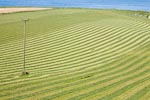
©2008
Marshall Ikonography
Irish Landscapes 2008 showcase
is now available here and via the main page Image Showcases link.
Taken during our extended trip to Ireland in September and October 2008, the images capture a bit of the beautiful light with which Ireland is blessed. The photographs hail from the all corners of the island: from the quiet north Antrim coast to the rugged landscape of the Dingle in the Southwest, from the majestic cliffs of Donegal in the north-west to the rolling hills of the Wicklow mountains just south of Dublin. The images are a mix of single image shots and stitched panoramas, each one glowing with the colours of late summer and autumn in Ireland. All are available as beautiful prints in the 12"x18" size at the regular prices. Stay tuned for the availability of larger fine-art prints.
2009-01-11: Happy New Year! We enjoyed a wonderful warm time with family in cold, bleak Ottawa. Truthfully, most of the heavy December snows that we've been getting stopped during the holidays. That made travel a little easier even if much of the visiting was via Skype.
As I mentioned in the previous News entry, the processing of the images from Ireland has taken a long time not only because of the number of images but because on this trip I was experimenting with both HDR (High Dynamic Range) images and multi-image panorama sequences. Both of these take a lot of extra processing to produce the final photograph. First the images are converted from RAW as a group and then they have to be post-processed into the final image. Both operations are computer and photographer intensive!
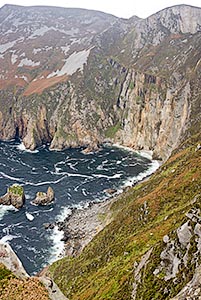
©2008 Marshall Ikonography
One successful and complex panorama image from Ireland is the image of cliffs and the sea in southern Donegal near Killybegs thumbnailed by the image on the right (click for a larger and pixel-peeping views). The creation of the image started with a harrowing drive on a single-lane, cliff-hugging road to the upper parking lot at Slieve League. From there it was a short hike up the path toward the One Man Pass where the tripod was set up to record a series of 10 carefully exposed and framed images of the massive cliffs. Each image in the sequence was taken at 70mm to try to give the image a wide angle look of a small view camera -- say a 4"x5" as I tried to caputure the size and majesty of the cliffscape. The final panorama is made up of 10 distinct images fused into a single large, 56 megapixel photograph (about 6000x9000) using Photoshop CS2's automerge process... 3 times: Once for the left side, once for the right and one more time to put the two sides together. After that, many of the edges and overlaps still needed work in Photoshop to get the image to merge together seamlessly.
It is well noted that CS3 and later versions of Photoshop do a much better job of stitching and blending that would require much less manual labour to produce a good image but since Lightroom is doing most of my image processing these days, I'm louth to pay for an expensive upgrade to a newer version of Photoshop. Instead, I'm currently looking at a few stand-alone programs to help with the stitching process.
The most promising experiment is with the open source program Hugin. To me it looks like a very viable alternative to the much more expensive (99 euro) commercial package Autopano Pro especially if you control a few variables in the camera and with the RAW processing. The documentation for Autopano Pro says that it can handle changes in the scene and movement during the extended exposure better than other stitching programs, but I might be able to either avoid scenes like that or just learn a bit more about Hugin and the tools that complement it. Hugin's user interface seems to be counter-intuative and the manuals are bare-bones, but I have been able to get some good results where CS2 failed miserably. I'm not usually trying to do awkward stitches: the Slieve League shot was taken with a long, relatively disortion free lens from a tripod with fixed exposures. But some initial experiments have shown that Hugin can help correct for wide-angle views that CS2 didn't have a hope of connecting. I'm also hoping that it will help with handling near-to-far errors.
In the future I'll be doing more with Hugin and perhaps even a Slieve League side-by side comparison. Aligning the closer detail at the same time as the distant cliffs in that shot requrired a lot of manual intervention with the merge in Photoshop CS2.
Also in the future is finding a quality printer for these images. My current maximum image size of 13"x19" just doesn't do these images justice. Of course neither does the small size of the thumbnail included in this entry!
I was expecting to have a few Ireland showcases by now, but more cleanup and classifying came first so that too will have to wait for next time.
2008-12-09: The on-line version of the Canadian
Geographic magazine features a virtual
PHOTOCLUB
which periodically highlights real photo
clubs in Canada. The RA Photo Club was recently profiled in
their featured Camera Club section.
The gallery associated with the RA Photo club includes two of my
images: Hagia Sophia Dome Support from our trip to
Istanbul in late 2007, reproduced here
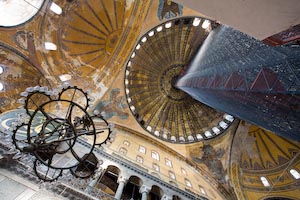
©2007
Marshall Ikonography
and Labnaha
Cenote, Tulum from our trip to Quintana Roo, Mexico
early in 2008, which you can still find at the 2008-03-26 entry on this
page.
Finally, the first few photos from the Ireland trip have made it to Alamy and World of Stock and the first processing and selection pass is complete. A showcase or two will be arriving shortly. This took a lot longer than expected partially due to the number of multi-image shots:
- I used the multi-shot mode a fair bit to try to get fewer camera motion artifacts, which then requires the slow process of picking the best from the two or three similars. I did find that I could batch the preview building by selecting a few hundred images and then have Lightroom build 1:1 previews for them all while I made and ate dinner or at least stayed away from the computer for a while. Of course, a quad-core processor might help with the speed that Lightroom builds the preview and everything else. Perhaps in 2009! Then we can look at Lightroom v2 too.
- I also experimented with HDR or High Dynamic Range photography on the Ireland trip. That requires you take a number of shots of a scene at very different exposures (by varying the shutter speed) and then merge them into an image with 32 bits of floating point information per colour per pixel. This compares with the 8-bits available in a JPeg image or the 12 or 14 bits available in the RAW precursor image. This can allow you to more accurately render a photograph that looks more like what the eye would see as you open up shadows without loosing the highlights while keeping the smooth transitions between the two. I haven't had much success with the technique so far, but I keep on trying!
- Ireland's landscapes pushed me toward panorama shots. The landscape is big and a wide angle lens doesn't always capture the sense of place. Using a slight telephoto and making the image of a number of overlapping shots can provide a view camera-like look from a portable and relatively small camera, like the Canon 5d. More on panoramas in another entry.
2008-10-25: The election is over and nothing has
changed. We were actually happy to have missed most of the
campaign while we toured Ireland in ignorance where, if we did see a
news report, it never mentioned Canada. As usual intentions
of doing updates from the road just didn't materialize.
Although we had pretty good borrowed WiFi connections at
many locations across the country, there just wasn't time.
Most of the daylight hours were filled with shooting and
touring. Evenings were taken up with pub crawls, CF card
downloads, minimalist tagging and a few emails and Skype
calls. Even our few wet days coincided with washer and
dryer availability so that another vital chore took the time.
It also overlapped our time travelling with another couple
which meant that trips out in the evening were even more
fun.
Standby for some short shows from the trip. Giant's Causeway
was awesome (again) and the Dingle shone. And as the photo
of our drive down toward Dingle town shows, there's lots of
green and many greens in Ireland.
I'm not yet sure of the efficacy of my sensor cleaning (see
below). Weeks into the trip (I should have looked earlier)
I found that small aperatures included a loop of dust that
came out almost totally in focus at f/25. A sweep of the
sensor brush seemed to clear it away for the last week, but
may have introduced some smears. A quick check shows that
it may have appeared shortly after the pre-trip cleaning.
It seems to show up on even early small aperature shots (not
too many of those of course since it rained for the first
couple of days).
I've resolved to check the sensor more often on future trips
(and to eventually get a self-cleaning (read, Mark II)
sensor).
2008-09-09: Well, we're deep into preparations for
our next trip to Ireland. Our last trip in the spring of
2005 was a great sucess and we're really looking forward to
some great images with a better camera and lenses. We're off this evening via Philadelphia and should be
settled near Dublin by tomorrow afternoon.
This time we'll be spending much
more time in the south including Wicklow, around Dublin and
the south west including Dingle. But we'll also be
revisiting some places in the North like the
Giant's Causeway, finding some new ones (for us) like the
Antrim Coast road and, if the weather holds up spending some more
time in Donegal too.
If things work
out, we might get an on-the-road
entry in this news section. WiFi seems to be wide spread in
the Emerald Isle.
2008-08-30: I've lately learned that if the original Eclipse fluid didn't ruin the 5d's sensor the first time it is used then it won't. I've switched back from E2 to using that isopropal alcohol-based fluid and I'm happier with the results. So my current cleaning procedure is a swipe (or two) of Eclipse and then a swipe with the static brush. A look with a magnifying glass and then another static swipe. At that point I check with the lens stopped down to f22 to see if the remaining spots are light and tolerable. I still don't seem to get it as clean as the 300D, but I'm getting there!
2008-07-17: I've been frustrated by the difficulty
in keeping the Canon 5d's sensor clean since I purchased the
camera. The excellent cleaning tools from Copperhill worked
well on the old Digital Rebel/300d, but even with a wider
spatula and swapping from the original Eclipse to the new E2
formulation it has been a continual battle to keep the dust
spots and smears from the 5d's sensor. Perhaps the edges
are too close to the edge of the chamber to get a good
cleaning in there. Or it is just a particularly attractive
surface for dust! Or my hands are less precise than they
used to be.
In frustration with the wet cleaners that
were always leaving streaks I decided to order the static
brush with Rocket blower from Copperhill. Interestingly it came with a set of
long Q-tips for cleaning sensor edges. (Not so interestingly,
it came with a multicoloured, plastic slinky (tm) too.) I
don't know if the q-tip cleaners were sent because I was
complaining about the edges of the sensor
or not, but I did a dusting and cleaning today using them and I think
that I have a pretty clean sensor again. As for the static
brush, there seems to be some oil in the 5d that all of
these brushes stir up. I tend to see streaks after their
use. Cleaning sensors is very stressful for me. I can't
wait for a camera that does most of this work for me!
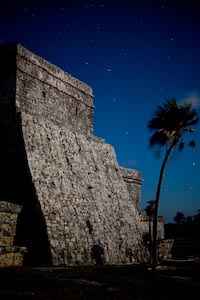
©2008
Marshall Ikonography
2008-06-23: I've assembled a new showcase of
images from our visit earlier this year to the states of Quintanta Roo
including Tulum and Yucatan in southern Mexico. These
images were
chosen primarily to allow one of my major patrons to
choose two prints for her growing collection of my work. A previous
entry here highlighted the dry Cenote at Labnaha so I'll
illustrate this one with a moonlit scene of the Castillo of
the Tulum Ruins from our dare-devil, after-hours trip to that
famous archeological site.
It was just past a full moon and our guide, a Canadian, who is
now a semi-permanent resident of Tulum, insisted that he knew the
back way into the site that avoided pesky things like
guards, tickets and even parking fees. It seems that in
1994 the entrance to this most visited site was redesigned
to keep the massive numbers of cars and coaches at a distance,
but the old entrance was never quite completely closed. As we motored up the
back road sometime after 2200 toward the old entrace he
doused the lights on the
old van. Of course it was a van temporarily imported from Canada and so
had daylight running lights so we weren't all that invisible.
But perhaps the guards didn't care. Once out of the
van we made our way in almost pitch black darkness (the moon
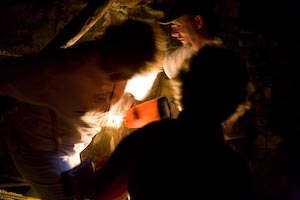
©2008
Marshall Ikonography
would rise high enough to provide some light by about 2240) along a fairly
well built stone path and then, with short busts of light from our
flashlights, though a mesh of yellow Do Not Cross
tape and some tree branches splayed across tunnel-like
passage through the thick walls. ("Tulum" in Mayan may mean
a walled place...) Our guide said that if we were challenged we
just had to say that we were going to the beach. All
beaches in Mexico are public and access to them must be
allowed. A moonlight swim with a Canon 5D, a few lenses
and a tripod ...Hmmm...
After an abortive attempt to leave via the new touristic exit,
scuttled when our guide poked his head above the
walls to see a guard doing his rounds below, we emerged,
close to midnight, the
way we came without incident. We sped away, past the downed
barrier gate with our still-lit van. And this was all
despite our feeble lighting of the
monuments with flashlight beams and lots of flash
shots from our accompanying travellers with their
point-and-shoot cameras.
Images from this series (and most other images highlighted on
this site) are available as high quality limited edition
prints at our regular prices.
To order, please contact me at  and quote the image number which appears below each image.
and quote the image number which appears below each image.
2008-06-13: We sometimes shoot with a tiny, pocket-sized
Sony T1 camera that is often with us when the big,
hulking Canon 5D is safely tucked in its bag at home or in
the trunk of the car. Last year, while at at a conference
in La Jolla, California, a walk along the cliffs
toward the town from our hotel on the beach produced some
intersting shots.
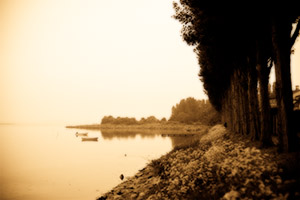
©2007
Marshall Ikonography
The morning light was beautiful, there was a bit of salty fog in the air
that probably deposited a bit of a
film on the T1's tiny (folded!) Zeiss lens. The photos of the rocks
and the sea lions had a wonderful painterly glow to them that I never
see with Canon's "L" lenses. I really liked how the camera had
captured the morning light, the details of the rocks and
animals and emphasized the glow of the faint morning mist.
A dusk walk along the very different shore of ÃÂrø (AEro) island in
Denmark made me think again of this smooth painterly T1 effect. I thought
that it might be just the
thing to capture the special soft evening light and the look of the row
of poplars, a couple of boats and even a duck in the
harbour. It was getting dark so without a tripod
using the Sony wouldn't have worked (the T1 has no tripod
thread), and anyway I did clean
the salt spray off the lens shortly after the Califonia
coastal walk!
So I took the image with the Canon 5D (hand held, but at
f2.8 with the 50mm
f1.8 lens) and thought of ways to post process it to try to
match the feeling of that quiet place.
I developed the image in
Lightroom using a tinted monochrome preset, Antique Light,
as well as some vingetting and contrast tweeking. The
Lightrooom result was then exported (as a 16bit TIFF) to Photoshop where
I used a digital Orton technique
along with some hand tuning of the effect for some of the
sharp dark edges. This produces a soft, warm, brownish-red
toned monochrome photograph
with a bit of a glow. The image displays both a sharpness
and softness that I find very pleasing. When reproduced
large 16 inch prints on Epson's Matte Paper -
Heavyweight the image looks quite stunning. The small
screen version looses some of the effect:
the sharpness and detail is
less pronounced. After working with the digital Orton technique a
bit I put together a series of images from the Denmark trip
that seemed to glow nicely with this technique. The result
is a small group of images in the
Denmark
Dreams showcase.
Images from this series (and other images highlighted on
this site) are available as limited edition
prints at our regular prices
(unchanged since 2006!). Please contact me to order.
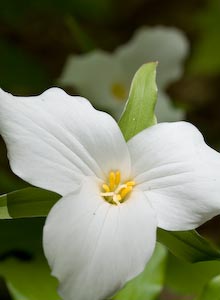
©2008
Marshall Ikonography
2008-05-20: A simple mis-step while out for a
neighbourhood walk a couple of weeks ago left me with a very
painful sprained ankle that has kept me from walking much. I
did get some indexing done (more from Turkey), with
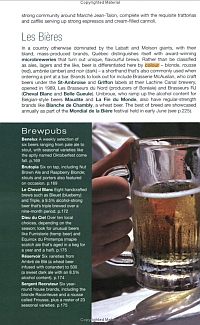 ice and a foot brace and a raised leg. After healing for
about a week I did manage to hobble down the street in an
older part of west Ottawa. There's a beautifully preserved patch
of forest named Elmhurst Park there and
I managed to just catch it before all the trilliums
finished. The leaves on the trees were out and the light
was muted and green. Once the wind came up the mosquitos
scattered but at the slow shutter speeds that I was working
at I had to be very lucky to get a sharp image. Of course, a
little flower shake can work too (try mousing over the
picture at the right).
ice and a foot brace and a raised leg. After healing for
about a week I did manage to hobble down the street in an
older part of west Ottawa. There's a beautifully preserved patch
of forest named Elmhurst Park there and
I managed to just catch it before all the trilliums
finished. The leaves on the trees were out and the light
was muted and green. Once the wind came up the mosquitos
scattered but at the slow shutter speeds that I was working
at I had to be very lucky to get a sharp image. Of course, a
little flower shake can work too (try mousing over the
picture at the right).
This was the first use of the Seagul right-angle viewer on
the 5D. I wasn't sure about how well it would work on the
full-frame camera, but for low camera angles on a tripod it
worked well. In this case it turned out to be essential since I was
dealing with a very inflexible left foot. It has been over
two weeks now since the sprain and I'm walking pretty
well again, but still feeling the pain on occasion,
especially in the morning. Perhaps it really is a hairline fracture.
My first tearsheet! I've sold quite a few
photographs through both Alamy and World of Stock, but you
usually only get very vague information about how the images
are actually used. It produces a strange disconnect from
your work. You know that the image was supposed to go into
a travel brochure or a textbook in Ireland, but you never
actually see how it serves that purpose.
Yesterday I was browsing around using
the interesting search engine at a9.com which includes in its search
the contents of some books
on sale at Amazon.com. The search engine reported that my
image of a hand with a beer mug made it into the 3rd edition of the Rough
Guide to to Montreal on page 116. It's probably the 2007
edition -- someone bought a 3 year licence to that image in 2006. Alamy said
that they licensed it for 1/4 page size, but when I looked
up the page (using Amazon's Search Inside feature) it looks more
like like 1/3 of a page to me! The picture wasn't taken in Montreal,
nor even in Quebec. We were sitting on some nice Adirondac
chairs at Ottawa's Britannia Yacht Club's open house enjoying a
couple of beers a few years ago.
2008-05-03: Spring is finally here! The last of the
snow left our property on April 21st and sudden warmth had
flowers pushing up even before all the snow was gone. It
has gotten a little cooler since those summer-like days in
late April, but great beds of tulips were up and in bloom in
time for the opening of Ottawa's Tulip Festival
yesterday. I took a walk around one corner of the Experimental
Farm and found a few very bright
red beds. Since it is still early there were lots of
daffodils too. So it is a tulip on the front page and one of
my favourite ones of the daffodils for this page.
The stock collections at Alamy passed the 1500 image
milestone over the past few weeks and the collection at our
Canadian agent, World of Stock is nearing the 1000 mark as
we finalize the stock images from Denmark and Mexico, continue to
make headway on the photographs from the Turkish trip and
mine some of the older images. Of course there's a few
images illustrating the near record Ottawa snow fall thrown in to
illustrate the exotic nature of this corner of Canada to the
world-wide audience. MyLoupe, our American distributer
continues to underperform so we've virtually stopped
submitting images there.
Planning for the fall trip to Ireland are progressing
well. It looks as if it may be Ireland only, with the original side
trip to Cornwall left for another trip. The logistics of
getting back and forth and the short timeframes involved
meant that it was just easier to plan for about 4 weeks in
the emerald island. Our time will be split between the
north and south with probably 2 weeks in the west centred on
Westport.
It is beginning to look as if
a long spring trip might prove
too hard to organize, but unless the price of gas gets to be
too much we'll probably take a short road trip or two. Watch
for the images!
I've decided that this news page is getting way too
long. So I've deleted the older entries.
2008-03-29: For some time now it has been clear that
with high resolution cameras like the Canon 5d and the type
of shooting that I tend to do when on trips that trying to
keep everything backed up and safe was getting to be a major
headache. At about the same time that I switched to the
Digital Rebel
from the the old Nikon Coolpix 990 I also started using DVDs for
backup rather than CDs. This provided a 8x capacity
increase per disk. But as I switched to RAW shooting on the
Rebel and
then upgraded the 5d, it was very clear that the
management of all of those DVDs and the splitting into
carefully managed 4.4GB DVD-sized chunks was
becoming getting too difficult. Access to the DVDs was also
very slow. I suppose that an obvious
backup medium would have been writable blu-ray disks, but
they're still very expensive and the writers too are pricey
and relatively slow.
Instead I've opted to use multiple, inexpensive, USB2 hard
drives. I'll buy them in pairs and keep one copy of the
archive locally and one off-site.
I purchased a pair of
320GB TekStor disks when they
went on sale at Future Shop earlier this month.
I had them shipped since none of the local stores had two in
stock... Unfortunately, they weren't packed for shipping
very well (one crumpled piece of newsprint in an oversized
shipping box) and one died
before I could finish a full reformat on it.
A couple of
weeks later Best Buy had 500GB LaCie drives on sale for a
similar price per GB so I tried again. It turns out that
there's no sleep mode on these drives so it makes sense from
a power perspective to
write them and then store them on a shelf. This I've done,
one here at Marshall Ikonography and another stored
safety off-site. These two basically archive work to date
and will be periodically updated as they reach capacity
(they're about 80% now), I'll get another pair. Now we have
disk chunks with over 100x the capcity of a DVD... a real
step up in chunk size!
The working TekStor, in contrast to the inexpensive
LaCie drives, spins down and just keeps a rather
bright blue LED running when the system sleeps. Thus that
disk has become my new near-line storage. It currently
provides a more convenient access to the archive of CDs and DVDs
that line a shelf in the office.
With the main (fast) internal disks freed of a lot of
archiving work I've finally been able to move the images
from Turkey and Mexico from the little
portable 2.5in 160GB drive onto the main disk drives. This
should provide faster access as I process these.
I've only done a little work in Lightroom with the new
arrangement and I haven't noticed a big difference yet.
SATA disks should be much faster, but perhaps
Lightroom is just a little too much for my sluggish
hyper-threaded (not dual or quad core) CPU.
2008-03-26: Finally I'm back writing here! We did the
Detroit trip and have been back for most of the heavy late
winter snows here in Ottawa. I've just been concentrating
on snow shoveling (driveway and cottage roof), indexing
stock photos from Washington, Denmark, Turkey and Mexco and
revamping my backup system. More on that latter project in
another post.
Back near the end of
February I was awarded three ribbons in the RA Photo Club competition
"Eyes":
- A wonderfully detailed glossy print of the dry cave or
cenote at Labnaha (see www.labnaha.com) won a first place and the Print of the Night ribbon. The thumbnail at the right doesn't do it justice. The print that was entered was 12"x18", but I think that a 16"x24" or larger print (24"x36" perhaps) would really draw the viewer into this eerie, otherworldly place. It is an incredible underground environment. Each of the images that I took were about 25s time exposures from a slightly unstable wooden walkway. This particular one used a 100mm Canon macro lens which provides an excellent corner to corner full-sized sensor image even when focused well beyond the macro range. Its f2.8 maximum apeture means that the 5d uses its high precision auto focus (but as I recall, I manually focused this shot).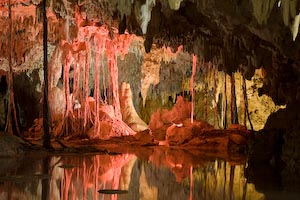
©2008 Marshall Ikonography
Shortly after I took this image and just as I was readying for another shot, I guess that our underground time was up and the really rather dim lights went out. I had no luck in trying to get them turned back on. I had to navigate my way out by continuing to moving toward the bright light of the exit. We hope to be back to revisit this cave (I've heard that the owners have extended the path inside since we were there in January) and view some of the other caves in the Yucatan around Tulum. - A print of the ceiling of the Blue Mosque in Istanbul pulled in a 2nd prize ribbon. It was printed on matt paper but exhibits much of the detail and complexity of the decoration of that majestic space. As with many of the ceiling images from Turkey (see the showcase Looking Up in Istanbul) it used my set the timer, set the wide angle zoom and exposure, place the camera lens up on the richly carpeted floor, trip the shutter and stand back so as not to include yourself in the shot while hoping that others (including camera thieves!) do the same technique of tripod-less photography in museums that prohibit steadying devices.
Somehow I don't think that I'll do as well in the RA Photo Club's March Faces and Figures competition.
